| Author |
Message |
|
Robert Hinds
|
 Posted: Mon 15 Oct, 2018 1:37 pm Post subject: Medieval army camp: what would it have looked like? Posted: Mon 15 Oct, 2018 1:37 pm Post subject: Medieval army camp: what would it have looked like? |
 |
|
Hey guys!
I was wondering if there are any sources detailing what a medieval armys camp would have looked like? Specifically what the layout would have been, would there be any defences thrown up and would they keep the same set up each night?
I'm referring to regular camps an army might make while going from point A to point B, not a siege camp.
I know of the wolfegg hausbuch and its depiction of the wagon circle and of machiavelli's proposed camp set up, copying the romans, from the art of war.
I guess I'm looking for stuff from earlier. Maybe hundred years war era, but any info you guys can give is appreciated!
Thanks! 
"Young knight, learn to love God and revere women; thus your honor will grow. Practice knighthood and learn the Art that dignifies you, and brings you honor in wars." -Johannes Liechtenauer
"...And he that hath no sword, let him sell his garment, and buy one..." Luke 22:36
|
|
  |
 |
Dan Howard

|
 Posted: Mon 15 Oct, 2018 3:20 pm Post subject: Posted: Mon 15 Oct, 2018 3:20 pm Post subject: |
 |
|
The Unconquered Knight by Gutierre Diaz de Gamez is worth reading. It doesn't tell us how a military camp was laid out but it tells us what it was like to live in one. They weren't very pleasant.
Author: Bronze Age Military Equipment, Pen and Sword Books
|
|
  |
 |
Jean Henri Chandler

|
|
  |
 |
|
Robert Hinds
|
 Posted: Fri 19 Oct, 2018 3:03 pm Post subject: Posted: Fri 19 Oct, 2018 3:03 pm Post subject: |
 |
|
Thanks for the replies, guys!
I'll have to check out that book...
"Young knight, learn to love God and revere women; thus your honor will grow. Practice knighthood and learn the Art that dignifies you, and brings you honor in wars." -Johannes Liechtenauer
"...And he that hath no sword, let him sell his garment, and buy one..." Luke 22:36
|
|
  |
 |
|
Henry O.
|
 Posted: Fri 19 Oct, 2018 7:41 pm Post subject: Posted: Fri 19 Oct, 2018 7:41 pm Post subject: |
 |
|
Vegetius' "De Re Militari" remained pretty widely read and influential during the middle ages so the idea of a fortified encampment wasn't exactly new. The main difference you start to see with machiavelli and later authors tends to be more angular designs, pronounced bastions, and more complex trenchworks inspired by the developing trace italienne designs.
You might also try looking through some of the Swiss Illustrated chronicles.
|
|
  |
 |
Tom King

|
 Posted: Mon 22 Oct, 2018 5:52 am Post subject: Posted: Mon 22 Oct, 2018 5:52 am Post subject: |
 |
|
Are there any extant examples of this type of wheeled wall? Are they stylized mantlets or moreso "war wagons"?

|
|
  |
 |
Jean Henri Chandler

|
 Posted: Mon 22 Oct, 2018 8:16 am Post subject: Posted: Mon 22 Oct, 2018 8:16 am Post subject: |
 |
|
I'm not sure what you mean by extant, a wagon fort still standing with all the wagons in a circle? One of the wagons still intact? The answer in the first case would be no, in the second case 'probably not' though I'm not sure, there might be one somewhere. They were still using war-wagons in the East as late as the 17th Century.
There are many replicas in museums, some of them may possibly include some parts from the originals I don't know

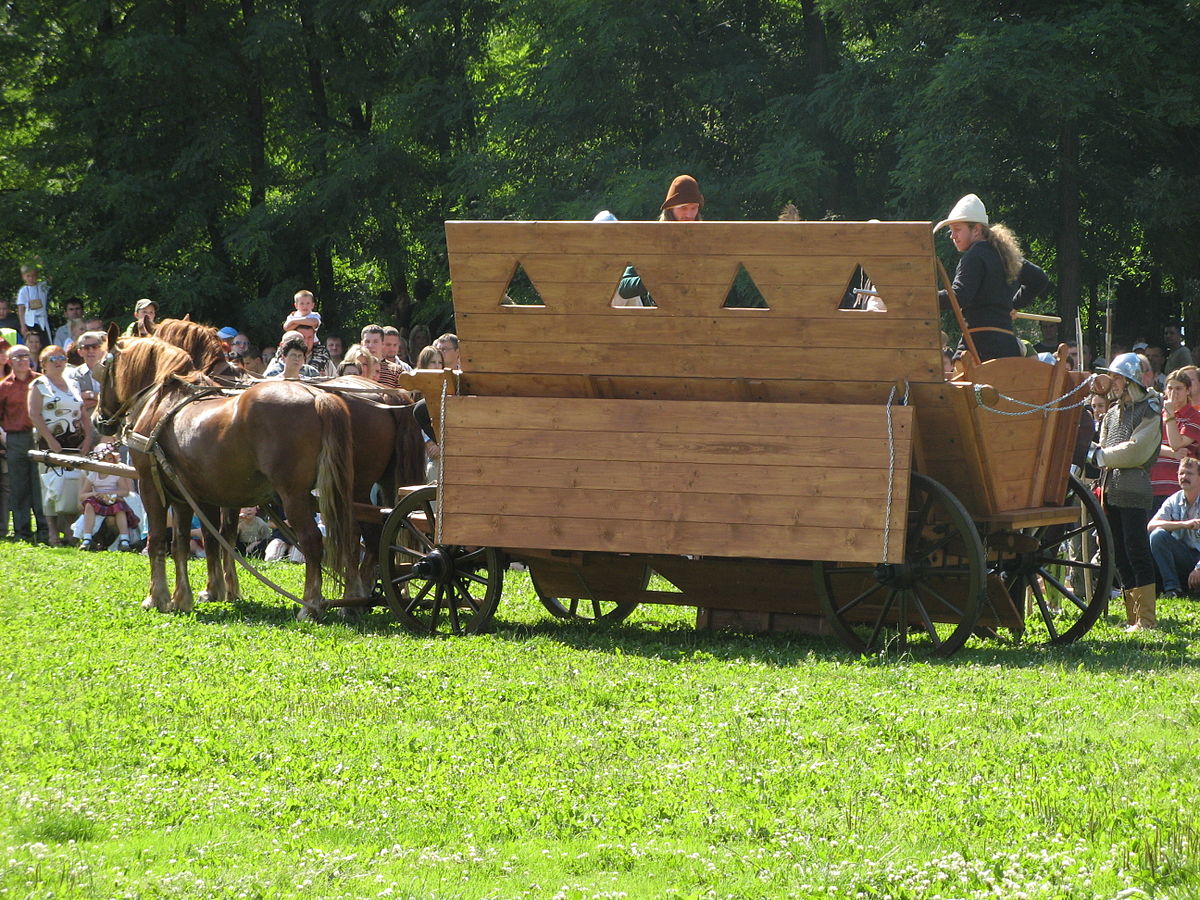
War wagons and gun-wagons were a steady part of medieval and Early Modern warfare which have been kind of hiding in plain sight, (along with guns more generally for the medieval context) and it's something a lot of folks miss. This is a brief overview:
The seeming invulnerability of the Czech armies in the original Hussite Wars in the 1420's-1430's (and then again later in the 1470's-1480's) led to their wide use as mercenaries both in Central Europe and further East, and the rapid emulation of their tactics and weapon systems, most importantly the firearm and light field gun, but also the war wagon.
What you see in that image was a common type of wagon laager used especially by urban militia in German speaking areas mainly in the second and third quarter of the 15th Century. The Czechs had kind of pioneered the use of cannons and firearms with such wagons in the Hussite Wars but the concept was already documented in books such as the (Czech) Bellifortis from ~ 1405 and in some other MSs as old as the 1390's. I suspect it goes a generation or two before that but the surge in popularity coincided with the Hussite Wars. Wagon laagers - sometimes known in late medieval context as 'Tabors' after the Czech term, go back all the way to Adrianople (5th Century BC) and before. The form in the Wolfegg image is typical - you'll notice the armed wagons form an outer circle while the lighter (wicker) supply wagons form the inner circle.
This is an image from the Wolfegg housebook of the same army on the march. Again you'll notice the armed wagons are on the outside of the column with the lighter supply wagons on the inside, per doctrine of the times.
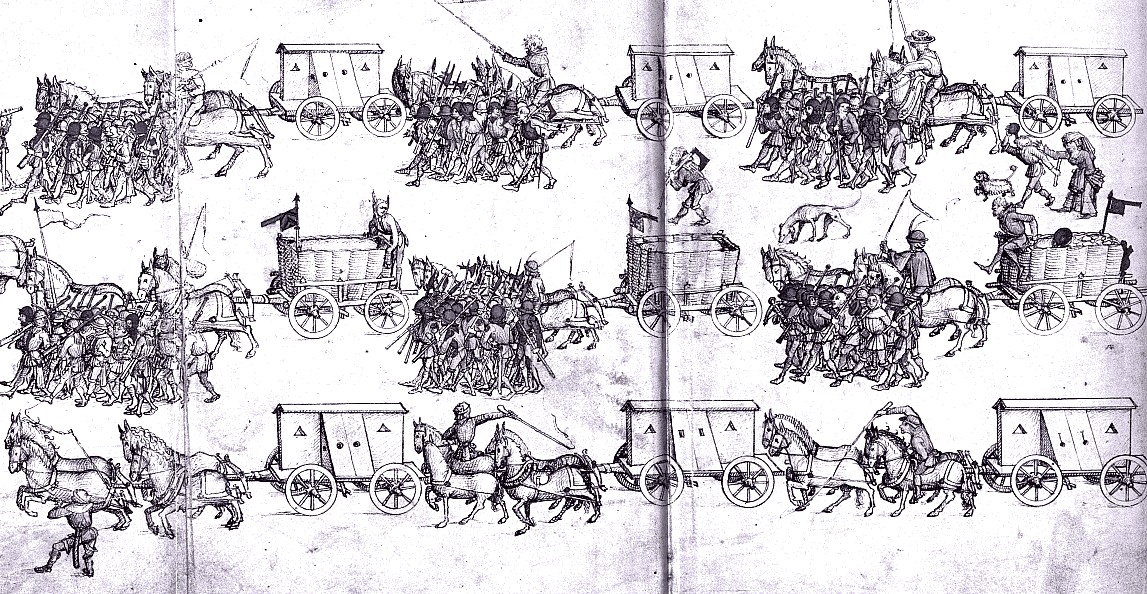
German war-wagons could be just basically mantlets with one gun. Some Russian ones were just mantlets without a gun, (with the gun wagons separate). Those ones in the wolfegg image I posted were of the mantlet with doors that could be opened or closed concealing a single medium caliber pintle-mounted gun - probably a breach loading gun. There are also two handgun or crossbow ports on each wagon.
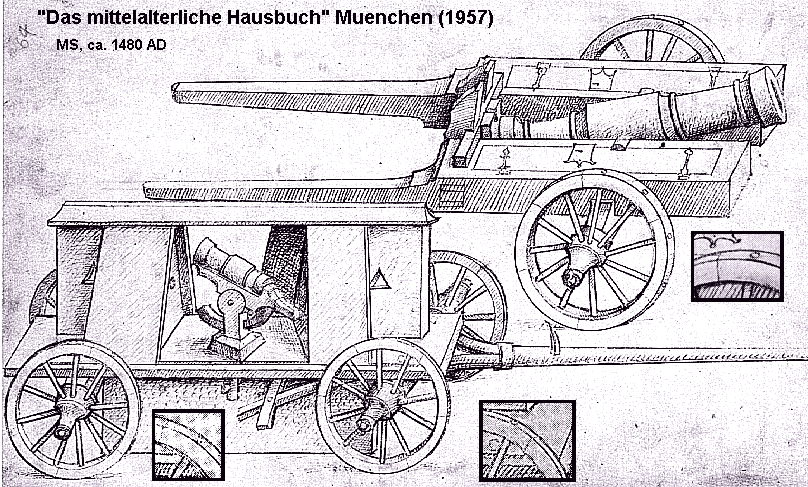
If you look closely in the map image I linked earlier, (I recommend using the high res image I linked in a url) you'll see one of them is in the open position. You'll also notice other interesting details like dead horses outside the camp, people gambling (and in one case about to murder one another), prisoners being brought in, beggars with children at the gate, and so on.
You also saw the Swiss using very similar type of war wagons as you see depicted here in the 1478 chronicle from Diebold Schilling

I should add though, these should not be confused with siege mantlets even though they also sometimes had wheels even guns mounted on them and look kind of similar. The difference is war wagons and gun wagons were for the open battlefield and could be used on the march, whereas siege mantlets were usually made on-site and used only during sieges.
Gun wagons and war wagons came in many variations though. This is another from the von Wolfegg housebook
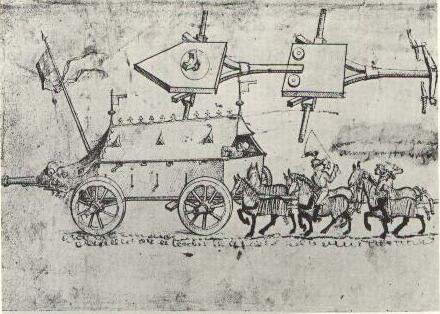
It was a common tactic to have them pushed from behind like that. You see it in many war-books from the era.
Gun wagons of various types were eclipsed in Western and most of Central Europe by around 1500 but remained popular in Eastern Europe due to their effectiveness against horse archers and Western cavalry alike. This Polish film fairly accurately depicts cossacks using Czech style tactics with light war wagons in the 17th Century (starting at about 04:40). Note the medium caliber pintle-mounted cannon mounted on the wagons.
https://youtu.be/c74uh5XoI2Q?t=286
The use of gun wagons continued in use in that part of the world all the way into the 1920's when the Ukranians reinvented them with maxim machine guns.

https://en.wikipedia.org/wiki/Tachanka
Hope that helps,
Jean
Books and games on Medieval Europe Codex Integrum
Codex Guide to the Medieval Baltic Now available in print
Last edited by Jean Henri Chandler on Mon 22 Oct, 2018 8:29 am; edited 1 time in total
|
|
  |
 |
Jean Henri Chandler

|
 Posted: Mon 22 Oct, 2018 8:27 am Post subject: Posted: Mon 22 Oct, 2018 8:27 am Post subject: |
 |
|
| Henry O. wrote: | Vegetius' "De Re Militari" remained pretty widely read and influential during the middle ages so the idea of a fortified encampment wasn't exactly new. The main difference you start to see with machiavelli and later authors tends to be more angular designs, pronounced bastions, and more complex trenchworks inspired by the developing trace italienne designs.
You might also try looking through some of the Swiss Illustrated chronicles. |
Vegetius is often brought up but by the later medieval period any Roman sources had been surpassed by miles, and many of the extant 'copies' of Vegetius by the 15th Century were really unrecognizable 'hacks' which were vastly more sophisticated than anything the Romans ever dreamed of.
One good warbook source for more permanent (i.e. as in dug out with pick and shovel) earthwork type fortifications are the various German and Italian war-books.

These are from the Kriegsbuch of Ludwig von Eyb. Fortified walls or barriers of this type were sometimes called "Letzi" in certain parts of Central Europe.
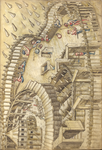
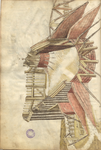
I didn't want to hot link because it's an academic website and I don't want to overload them, but you can see more detailed images here:
http://digital.bib-bvb.de/view/bvbmets/viewer...ePid2=true
http://digital.bib-bvb.de/view/bvbmets/viewer...ePid2=true
Von Eyb also shows a wide variety of pretty well illustrated war machines of many different types as well as the various camp and march formations for war wagons, of which he was familiar as he fought and defeated Czech mercenaries during the Landshut War of Succession in 1505. It's worth a look at his manual:
https://wiktenauer.com/wiki/Eyb_Kriegsbuch_(MS_B.26)#Gallery
Medieval armies, particularly in Central Europe or Italy, almost always brought along skilled artisans with them and were capable of very efficient and rapid feats of military engineering in the field. They would routinely build small forts and blockhouses, or things like pontoon bridges within a matter of a couple of days, and could erect fairly formidable stone castles within weeks. The Teutonic Order erected castles during almost every one of their 200 some odd semi-annual Reysa or raids into Lithuanian territory, though many of them were quickly destroyed. Some are still extant.
To help make sense of the crazy stuff in the illustrated war manuals I recommend reading Christine de Pisans war book, she gives you a good idea of the (rather incredible) quantities of logistics, ammunition, food, weapons etc. that go into a moderately significant siege.
I would say in my opinion we tend to underestimate the innovative and organizational capabilities of medieval armies, especially late medieval armies, very generally speaking.
Jean
Books and games on Medieval Europe Codex Integrum
Codex Guide to the Medieval Baltic Now available in print
|
|
  |
 |
Jean Henri Chandler

|
 Posted: Mon 22 Oct, 2018 11:34 am Post subject: Re: Medieval army camp: what would it have looked like? Posted: Mon 22 Oct, 2018 11:34 am Post subject: Re: Medieval army camp: what would it have looked like? |
 |
|
| Robert Hinds wrote: | Hey guys!
I'm referring to regular camps an army might make while going from point A to point B, not a siege camp.
I know of the wolfegg hausbuch and its depiction of the wagon circle and of machiavelli's proposed camp set up, copying the romans, from the art of war.
I guess I'm looking for stuff from earlier. Maybe hundred years war era, but any info you guys can give is appreciated!
Thanks!  |
Hey Robert I'm sorry I don't know how I missed the part about not wanting to see the the Wolfegg housebook wagon laager - my apologies
For the 100 Years War era specifically I'd recommend looking for the many different illustrated versions of the Froissart chronicles, which come mostly from Flemish towns and / or Burgundy. Many of these were illustrated though in the 15th Century so they may not reflect the realities of the earlier period.
For the 15th and early 16th Century, aside from the kriegsbucher which i already mentioned, I believe these are from Leonhard Fronsperger - it does also include wagons but many of them do from this era.


Edit: found this in higher res here

as Henry O already noted the Swiss Chronicles do show a lot of details of army camps though most of them are probably associated with sieges. If you spent some time you could find examples of armies clearly camping in the field and not involved in a siege, and many examples of armies on the move. To get a field camp you'll probably have to find a site where the whole chronicle is hosted and go through it page by page, google is only going to take you to the most famous images.
Siege camps show such interesting details as 'victualing'
https://upload.wikimedia.org/wikipedia/commons/9/93/Schilling_Spiezer_Chronik_16.jpg
production of ammunition and weapons
https://i.pinimg.com/originals/1b/b7/fc/1bb7fcc2de07e36708dbbf9e47c28ea5.jpg
and lots of examples of how guns / cannon were managed.
Another possible source you might find useful is the Norwegian Kings Mirror. (13th Century) I know he has a lot of interesting stuff on siege warfare
https://archive.org/stream/kingsmirrorspecu00konuuoft/kingsmirrorspecu00konuuoft_djvu.txt
and for a later era, you might try Maximilians Der Weisskunig, wonderfully illustrated by Hans Burgkmair and other gifted artists
https://en.wikipedia.org/wiki/Weisskunig
https://www.mfa.org/collections/object/der-weisskunig-the-white-king-36772
you'll find a lot of depictions of armies on the move etc. I believe there is a section in it of setting up a military camp.
https://upload.wikimedia.org/wikipedia/commons/d/d7/Der_Weisskunig_26_Detail_Maximilian_on_horseback_in_besieged_town.jpg
Finally Paul Dolnstein (a new dissertation on whom was recently discussed here in another thread by the Author) and Urs Graf can give you some ideas about camp life.

Books and games on Medieval Europe Codex Integrum
Codex Guide to the Medieval Baltic Now available in print
|
|
  |
 |
Blaz Berlec

|
|
   |
 |
|
Len Parker
|
|
  |
 |
|
|
You cannot post new topics in this forum
You cannot reply to topics in this forum
You cannot edit your posts in this forum
You cannot delete your posts in this forum
You cannot vote in polls in this forum
You cannot attach files in this forum
You can download files in this forum
|
All contents © Copyright 2003-2025 myArmoury.com — All rights reserved
Discussion forums powered by phpBB © The phpBB Group
Switch to the Basic Low-bandwidth Version of the forum
|

